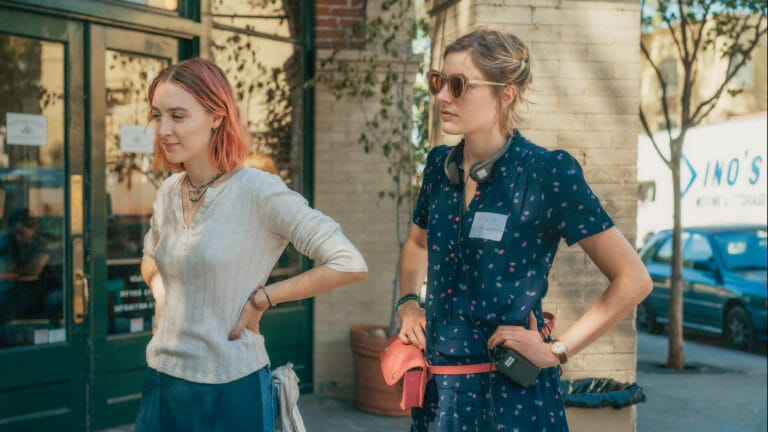By Shanee Edwards · December 13, 2017

Honest, raw and funny, Lady Bird is a coming of age story about a high school senior, Christine “Lady Bird” McPherson (Saoirse Ronan), trying to navigate Catholic school while planning her escape from the stifling confines of Sacramento. Indie actress Greta Gerwig both wrote and directed the film, this time giving a stellar performance behind the camera.
A masterful actress who can easily switch between comedy and drama, Gerwig proves she’s able to do the same thing with her writing. Lady Bird is full of laugh out loud sequences that can slip into poignant moments of humiliation, anger and self-discovery. The film is a master class in tonal cohesion.
We met up with Gerwig at the Four Seasons Hotel in Beverly Hills to find out everything she’s learned about writing from acting and studying theater.
Read More: A Chronological Timeline of Greta Gerwig’s Writing

As an actress, Gerwig has studied some of the best playwrights of all time. Through studying their plays, Gerwig has learned what makes a compelling protagonist, a ruthless antagonist and a story that resonates.
“Acting is so important for me, obviously as a writer, because it was the way I really understood great writing by trying to do it as an actor,” says Gerwig. “Also realizing when you do work with great writing, doing scenes from Tennessee Williams, Carol Churchill, Eugene O’Neil or Kenneth Lonergan, it works on you – it works on you. It’s not that there’s a right way to do it, it’s that you open yourself to the possibility of what the text is giving you.”
“People say that acting is listening, but I find that writing is listening as well.” Gerwig says that by listening to her characters, “A lot comes up that you never could have anticipated, or you didn’t know was in you, or you didn’t know those characters were going to say. That’s always where I find the real heart of it.”
As an actress, Gerwig has spent a great amount of time creating characters. This means doing a lot more work than just giving a character a history or a bio. Great actors create ways to inhabit characters physically, they may give them a vocal quality that’s different than their own and they give them secrets and flaws. It’s only after these “people” are fleshed out that Gerwig will create an outline for her screenplay.
“I don’t start with structure, for me that comes later. I start with moments and people. I find that the story comes from the characters Structure is very important to me – the way a plot is woven and moves – but it’s not something I can figure out ahead of time. I outline, but later. After I have it, then an outline becomes useful. Then I know what the skeleton is.”
Read More: The Oddly Relatable Characters in Greta Gerwig Movies

Actors obviously have to learn their lines and that process helps to internalize highly effective words, rhythms and humor.
“For me, so much of my learning how to write was taking in other great writers and even that process of memorization is an incredibly helpful thing. I think people underestimate memorization as an artistic thing because they see it as rote memorization, as if it’s not something that’s valuable or creative. But there’s something about memorizing text that’s great. Words that are great get inside of you, they become part of you. With memorization, the words move to a part of your brain – almost the automatic part of it, so if you have an automatic ability to say Shakespeare for example, that’s in there. So when you sit down to write, some of those rhythms are in there. It’s your job to find your own, but also it’s a way to engage with something that is bigger than you are.”
For instance, anyone who’s ever memorized Abbot & Costello’s “Who’s on first” comedy routine has embedding in their body the “rule of three” comedic principle.
Gerwig understands that actors need to create their own secret world away from the writer or director. Adding their personal creative alchemy is what makes good characters great.
“Part of being an actor is really having to own the character, and if someone is always telling you, “no, no, no, it’s like this; it’s like that” you never really feel like the part is yours. My job was to create a perimeter so they could take it over from me, because it wasn’t mine anymore.”
Like many of us artistic types, Lady Bird is a theater nerd and of course she’s acting in the school musical Merrily We Roll Along. Gerwig didn’t choose this play at random.
“Merrily We Roll Along is my favorite musical. My hope for Lady Bird is that it gives audiences a little bit of the feeling that I got watching Sondheim’s Merrily for the first time. That sense of time slipping away, the future charging into the present, the bonds of childhood as only living on in memory. It is aching and beautiful and fleeting and the thing I always look for in art.”
Adding a play with in a play (or movie) is a literary device where the nested story typically parallels the larger story and serves as a guide for the characters. Perhaps the most famous is the one Shakespeare uses in Hamlet.
In this case, Merrily We Roll Along is helping both Lady Bird and the audience prepare for Lady Bird’s transformation into adulthood.